💡 In this playbook you will get prompts, templates, cheatsheets, and step-by-step instructions to master keyword research.
Keyword research is a complex and long topic, while we made this playbook simple, it is long to cover all aspects of it.
Introduction: Why Keyword Research Matters
Keyword research isn’t just an SEO task—it’s the foundation of your entire digital marketing strategy. Get it right, and you’ll attract qualified traffic that converts. Get it wrong, and you’ll waste resources creating content nobody searches for.
This playbook will take you from keyword research basics to advanced strategies, with actionable steps using both free and paid tools. Whether you’re a small business owner or an SEO professional, you’ll find practical techniques to discover keywords that drive real business results.
Keyword Research Fundamentals
What Is Keyword Research (And Why It Matters)
Keyword research is the process of discovering the actual search terms people use when looking for products, services, or information online. It reveals:
- What your audience is searching for
- How they phrase their searches
- How difficult it will be to rank for those terms
- Which topics have the highest commercial potential
Effective keyword research helps you:
- Create content that matches user intent
- Prioritize your content creation efforts
- Identify low-competition opportunities
- Understand the language your customers use
- Discover gaps in your current content strategy
Understanding Search Intent
Search intent is the “why” behind a search query—what the searcher hopes to accomplish. There are four main types:
- Informational: Seeking knowledge (“how to do keyword research”)
- Navigational: Looking for a specific website (“The SEO Hustler”)
- Commercial: Researching before purchase (“best keyword research tools”)
- Transactional: Ready to buy (“buy Ahrefs subscription”)
Matching your content to the correct search intent is crucial. A transactional page won’t rank for an informational query, no matter how well-optimized it is.
Key Metrics to Understand
When evaluating keywords, consider these essential metrics:
- Search Volume: How many times a keyword is searched monthly
- Keyword Difficulty: How hard it will be to rank for the term
- Click-Through Rate (CTR): What percentage of searchers click on results
- Cost Per Click (CPC): What advertisers pay for the keyword (indicates commercial value)
- Search Intent: The purpose behind the search
- Trend Data: Whether interest is growing, stable, or declining
Setting Up Your Keyword Research Strategy
Defining Your Goals and Audience
Before diving into tools, clarify what you’re trying to achieve:
- Business Goals: Are you focused on brand awareness, lead generation, or direct sales?
- Target Audience: Who are you trying to reach? What problems do they have?
- Content Types: Will you create blog posts, product pages, videos, or other formats?
- Competitive Position: Are you a new site needing quick wins or an established site looking to defend rankings?
- Resources: What time, budget, and content creation capabilities do you have?
These factors will shape your keyword strategy and help you prioritize opportunities.
Creating Your Keyword Research Framework
A structured approach ensures you don’t miss opportunities:
- Seed Keyword Generation: Identify core topics related to your business
- Keyword Expansion: Use tools to find related terms and variations
- Competitive Analysis: Discover what’s working for competitors
- Search Intent Mapping: Group keywords by user intent
- Difficulty Assessment: Evaluate ranking difficulty against your site’s authority
- Prioritization: Score and rank keywords based on business value
- Content Mapping: Assign keywords to existing or new content
- Implementation Planning: Create a roadmap for content creation and optimization
Brainstorming Seed Keywords
Internal Sources for Keyword Ideas
Start with what you know about your business:
- Product/Service Descriptions: What do you sell or offer?
- Customer Questions: What do people ask before buying?
- Sales Team Input: What terms do prospects use in conversations?
- Support Tickets: What problems do customers need help with?
- Internal Search Data: What do people search for on your website?
- Existing Content Performance: What’s already working?
Document these terms as your initial seed keyword list.
Competitor Analysis for Keyword Discovery
Your competitors have already done some of the work for you:
- Identify Competitors: List direct business competitors and top-ranking sites for your target terms
- Analyze Their Top Content: What topics are they covering?
- Review Their Site Structure: How do they organize their content?
- Check Meta Information: What keywords appear in their titles and descriptions?
- Examine Internal Links: What pages do they prioritize?
Tools like Ahrefs can accelerate this process by showing exactly what keywords competitors rank for.
Using Ahrefs Keyword Explorer
Introduction to Ahrefs Keyword Explorer
Ahrefs Keyword Explorer is the Swiss Army knife of keyword research tools. It’s not the cheapest option out there, but there’s a reason why serious SEO professionals consider it worth every penny.
What makes it stand out is the depth and accuracy of its data. While free tools might give you surface-level insights, Ahrefs digs deeper with metrics like:
- Keyword difficulty scores based on actual backlink data
- Click metrics that show how many people actually click on results (not just search)
- Parent topic identification to help structure your content
- SERP feature analysis showing what type of content Google wants to show
Setting Up and Navigating the Interface
When you first log into Ahrefs Keyword Explorer, you’ll see a clean search interface. Here’s how to get started:
- Select your target search engine and country (e.g., Google US)
- Enter your seed keyword or a list of keywords (up to 10,000 at once)
- Click the search button to generate results
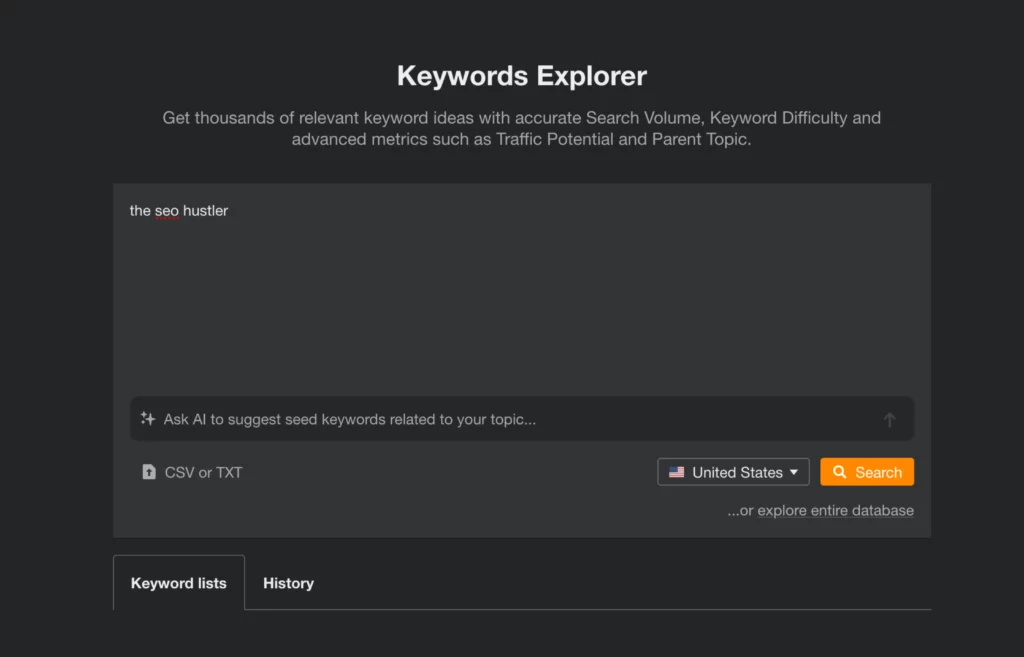
The navigation is divided into several key sections:
- Overview: Summary of key metrics and at-a-glance data
- Matching terms: Keywords containing your seed keyword
- Related terms: Semantically related keywords
- Search suggestions: Based on Google autocomplete
- Questions: Who, what, when, where, why, and how queries
- Newly discovered: Recently added to Ahrefs database
- SERP overview: Analysis of current top-ranking pages
Finding Keyword Ideas with Ahrefs
Ahrefs excels at expanding your seed keywords into a comprehensive list of opportunities. Here’s how to mine it for gold:
After entering your seed keyword, you’ll see several reports in the left sidebar:
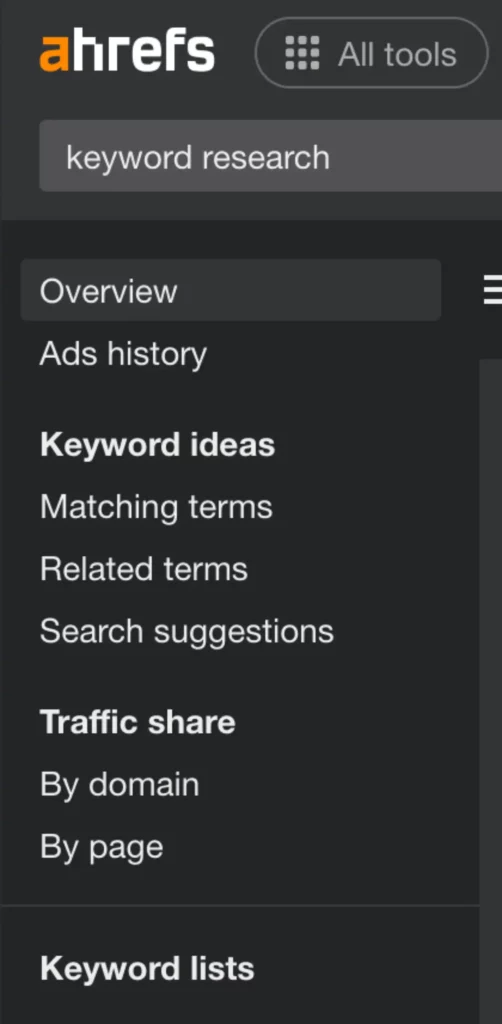
- Matching terms: Shows keywords containing your seed keyword
- Related terms: Displays semantically related keywords that may not contain your seed keyword
- Search suggestions: Based on Google autocomplete data
- Questions: Filters for who, what, when, where, why, and how queries
- Newly discovered: Shows keywords recently added to Ahrefs database
For each report, you can apply filters to narrow down results by:
- Keyword difficulty
- Search volume
- Word count
- Include/exclude terms
- Click metrics
- SERP features
Analyzing Keyword Metrics
Ahrefs provides several key metrics to help you evaluate keywords:
Volume
This estimates monthly search volume based on clickstream data. But don’t get hung up on this number alone—a lower-volume keyword with high intent can be more valuable than a high-volume term with vague intent.
Keyword Difficulty (KD)
Scored from 0-100, this estimates how hard it would be to rank in the top 10. It’s based primarily on the backlink profile of current ranking pages.
- 0-10: Easy to rank with minimal backlinks
- 11-30: Possible with quality content and some backlinks
- 31-70: Challenging, requiring strong content and link building
- 71-100: Extremely difficult, typically dominated by authority sites
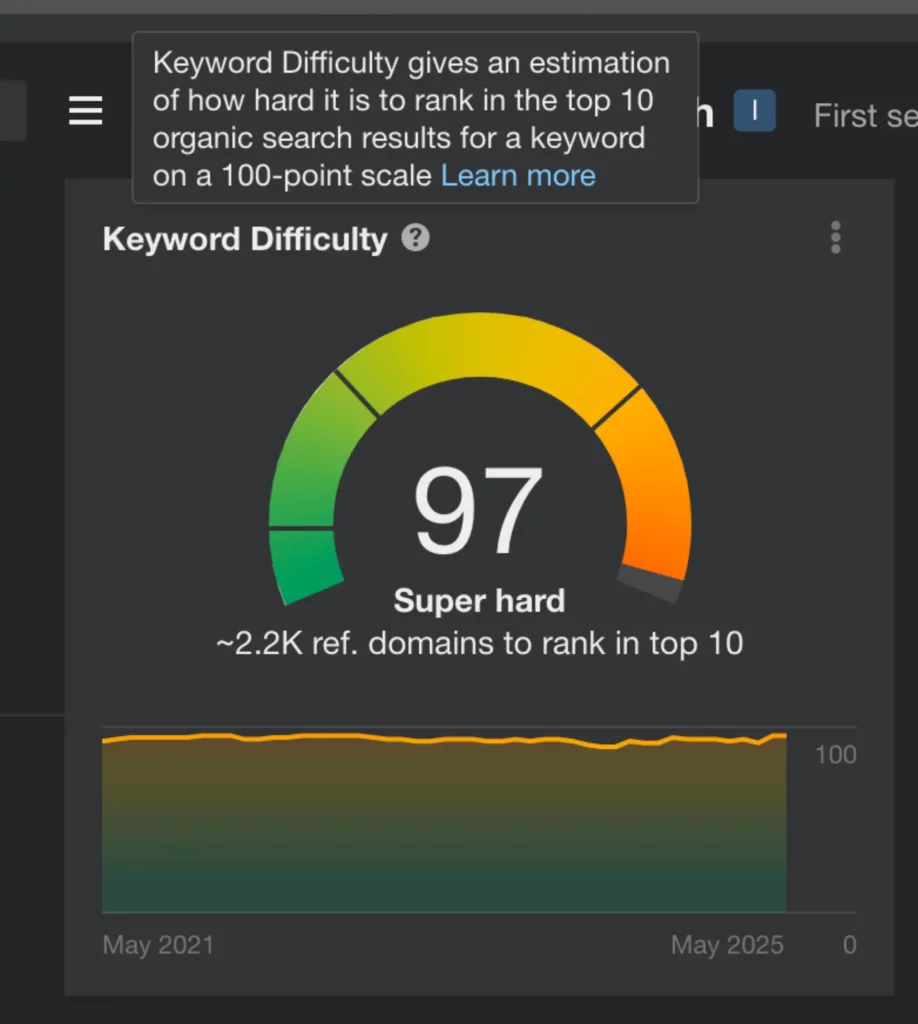
Traffic Potential
This metric estimates the total traffic you could get if you ranked #1 for the keyword, based on the traffic of the current top-ranking page. This is often more valuable than just looking at search volume.
Parent Topic
This shows a broader topic that might be easier to target and could rank for your keyword anyway. It helps you avoid creating multiple pieces of content that might compete with each other.
Advanced Filtering Techniques
The real power of Ahrefs comes from combining filters to find the perfect keywords. Here’s a filtering strategy that works:
- Start broad with your seed keyword
- Apply a KD filter based on your site’s authority (start with KD < 30 if you’re new)
- Set a minimum volume threshold (e.g., 100+ monthly searches)
- Filter for keywords with commercial potential (CPC > $1)
- Exclude branded terms if needed
- Include only question-based keywords if creating informational content
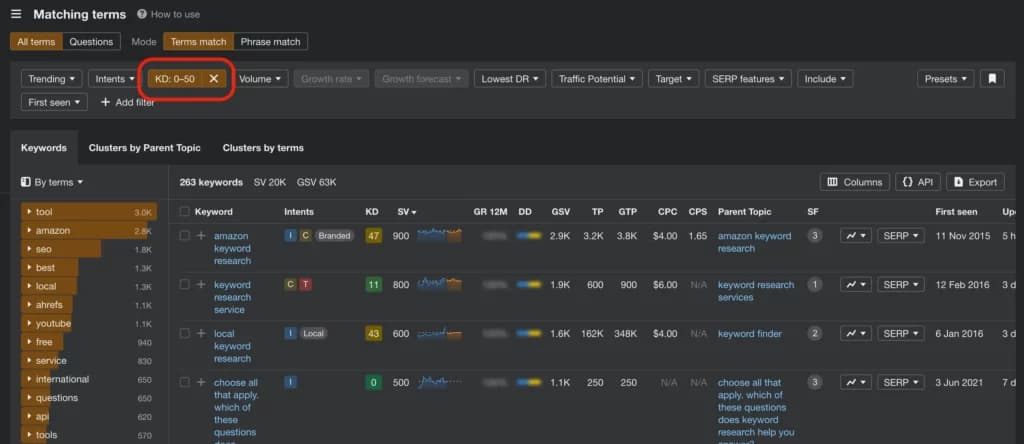
Leveraging The SEO Hustler’s Advanced Keyword Analysis Tool
Introduction to TSH’s Free Keyword Analysis Tool
While Ahrefs is powerful, not everyone has the budget for premium tools. That’s where The SEO Hustler’s Advanced Keyword Analysis Tool comes in—a free alternative that delivers professional-grade insights without the price tag.
What makes our tool different? Unlike most free tools that scrape limited data or provide basic metrics, our Advanced Keyword Analysis Tool gives you a deep dive into a single keyword, focusing on actionability:
- Key Metrics Overview: Get instant insights into Search Volume, CPC, Keyword Difficulty, and our unique Opportunity Score.
- Detailed Keyword Overview: Understand the primary Search Intent, Parent Topic, and key SERP Features present.
- SERP Analysis: See the top-ranking pages with their crucial metrics.
- Keyword Trends: Visualize search volume fluctuations over time.
- Comprehensive Keyword Table: Explore related keywords, questions, and variations with detailed metrics.
The best part? You get 10 free analyses daily—more than enough to build a solid keyword strategy without spending a dime.

How It Differs from Paid Tools (Unique Benefits)
Paid tools like Ahrefs excel at volume and breadth of data. Our tool takes a different approach, focusing on depth and actionability for a specific keyword:
| Paid Tools | The SEO Hustler’s Tool |
|---|---|
| Broad keyword databases | Focused, deep analysis of one keyword |
| Raw data requiring interpretation | Actionable insights and recommendations |
| Learning curve to use effectively | Simple, intuitive interface |
| Monthly subscription costs | Completely free (10 analyses daily) |
| General metrics | Context-specific opportunity scoring & SERP breakdown |
The key difference? Our tool doesn’t just give you a massive list—it gives you a focused analysis to help you understand how to rank for a specific keyword.
Step-by-Step Guide to Using the Tool Effectively
Let’s walk through how to get maximum value from the Advanced Keyword Analysis Tool:
1. Access the Tool
Navigate to https://theseohustler.com/advanced-keyword-analysis
or use below
2. Enter Your Target Keyword
In the search box, enter the keyword you want to analyze. Be specific—instead of “SEO,” try “local SEO for restaurants” or “technical SEO audit checklist.”
3. Review the Summary Dashboard
At the top, you’ll see the core metrics for your keyword:
- Search Volume: Estimated monthly searches.
- CPC: Average Cost Per Click in Google Ads, indicating commercial value.
- Keyword Difficulty (KD): A score (0-100) estimating ranking difficulty.
- Opportunity Score: Our proprietary metric (0-100) indicating the potential for your site to rank, considering relevance and competition.

4. Analyze the Keyword Overview
This section provides crucial context:
- Search Intent: Identifies the primary user goal (Informational, Commercial, Transactional, Navigational).
- Parent Topic: Suggests a broader topic your keyword falls under, potentially offering a better target.
- SERP Features: Shows features like Featured Snippets, People Also Ask boxes, Video Carousels, etc., present on the results page.

5. Examine the SERP Analysis
See the current top 10 ranking pages with key data points like:
- URL
- Domain Rating (DR)
- URL Rating (UR)
- Estimated Traffic
- Number of Keywords the page ranks for
This helps you understand the competitive landscape and the authority required to rank.
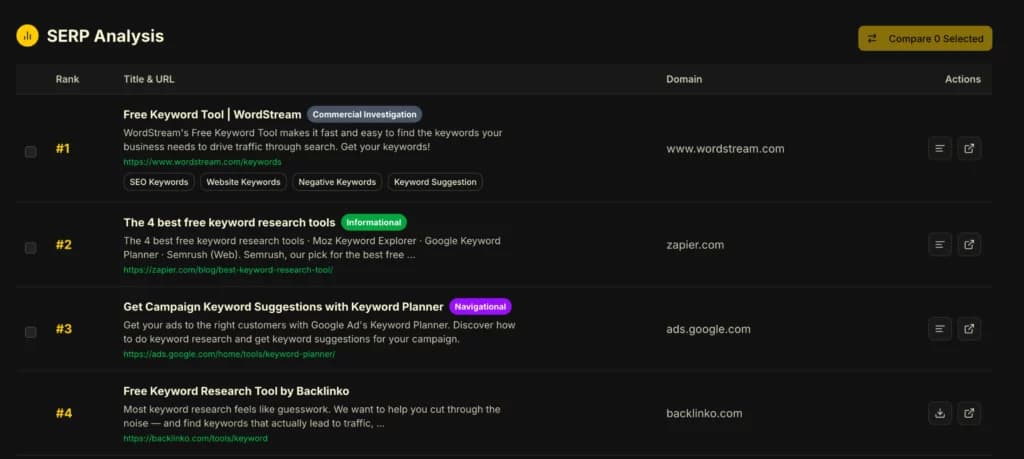
6. Check Keyword Trends
A graph visualizes the search volume trend for your keyword over the past 12 months, helping you identify seasonality or shifts in interest.

7. Dive into the Keyword Table
This is where you find related keyword ideas, questions, and variations, presented in a detailed table with columns for:
- Keyword: The suggested term.
- Volume: Estimated monthly search volume.
- KD: Keyword Difficulty score.
- CPC: Cost Per Click.
- PPC: Paid Per Click competition level.
- Score: Opportunity Score for that specific related keyword.
Use the filters (All, Related, Questions) to explore different types of variations.
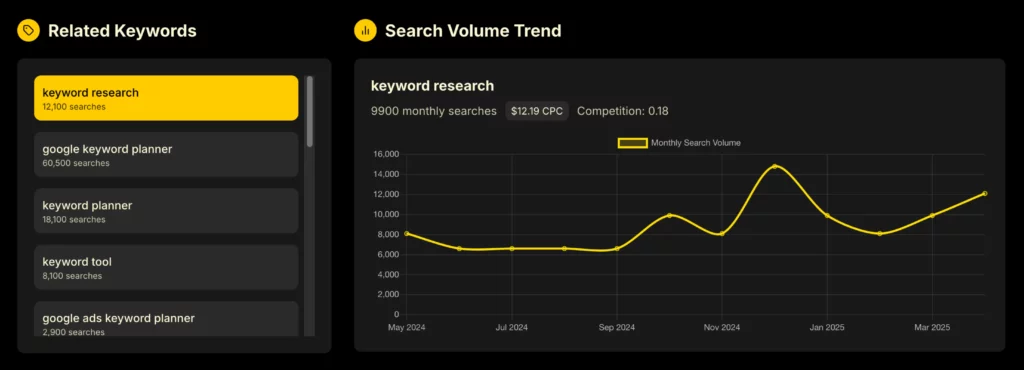
Interpreting the Analysis Results
The real value comes from understanding what the data means for your specific situation:
- High Opportunity Score? Indicates a good potential target, especially if KD is manageable.
- Low Opportunity Score but High Volume? Might be too competitive or irrelevant; check the Parent Topic for better angles.
- Mismatch between Keyword and SERP Content? Could signal an opportunity to create content that better matches intent.
- Strong Seasonality in Trends? Plan your content creation and promotion accordingly.
- High CPC? Suggests strong commercial intent; prioritize if conversions are your goal.
Using The SEO Hustler’s Content Planning Tool
Introduction to the Content Planning Tool
Once you’ve identified your target keywords, the next step is turning them into effective content. The SEO Hustler’s Content Planning Tool bridges the gap between keyword research and content creation.
This free tool helps you:
- Organize keywords into strategic content pieces
- Create comprehensive content briefs
- Ensure search intent alignment
- Plan internal linking structures
- Schedule content for maximum impact
How to Create a Content Plan from Your Keywords
Follow these steps to transform your keyword list into an actionable content plan:
- Import Your Keywords: Upload your researched keywords or enter them manually
- Group Related Keywords: Cluster keywords by topic and intent
- Define Content Types: Decide whether each cluster needs a blog post, landing page, product page, etc.
- Set Content Priorities: Rank content pieces by potential impact and resource requirements
- Create Content Briefs: Generate detailed outlines for each piece
- Establish Publishing Schedule: Set realistic timelines based on your resources
The tool guides you through each step with templates and recommendations.
Optimizing Content Structure for SEO
The Content Planning Tool provides specific structural recommendations based on your keywords:
- Title Suggestions: SEO-friendly title formats that include your target keyword
- Heading Structure: H1, H2, and H3 recommendations based on related keywords
- Content Sections: Suggested topics to cover based on top-ranking pages
- Word Count Guidance: Recommended length based on SERP analysis
- Media Recommendations: Types of images, videos, or other media to include
- Internal Linking Opportunities: Suggestions for connecting to existing content
These structural elements ensure your content is comprehensive and competitive.
Planning Your Content Calendar
Beyond individual pieces, the tool helps you develop a strategic content calendar:
- Content Sequencing: Which pieces to publish first to build topical authority
- Seasonal Planning: When to publish time-sensitive content
- Content Gaps: Identifying missing pieces in your content strategy
- Update Schedules: When to refresh existing content
- Resource Allocation: How to distribute writing and production resources
This calendar view helps you maintain consistent publishing while maximizing SEO impact.
Leveraging ChatGPT for Keyword Research
How AI Can Enhance Your Keyword Research Process
AI tools like ChatGPT aren’t just for writing content—they’re powerful allies in your keyword research arsenal. While traditional keyword tools excel at providing metrics and data, ChatGPT shines at understanding context, generating creative variations, and mimicking how real people think and search.
Here’s where ChatGPT adds unique value to your keyword research:
- Brainstorming seed keywords from different perspectives
- Identifying search intent nuances that data-driven tools might miss
- Generating long-tail variations that capture conversational queries
- Uncovering industry-specific terminology you might overlook
- Simulating customer questions at different stages of awareness
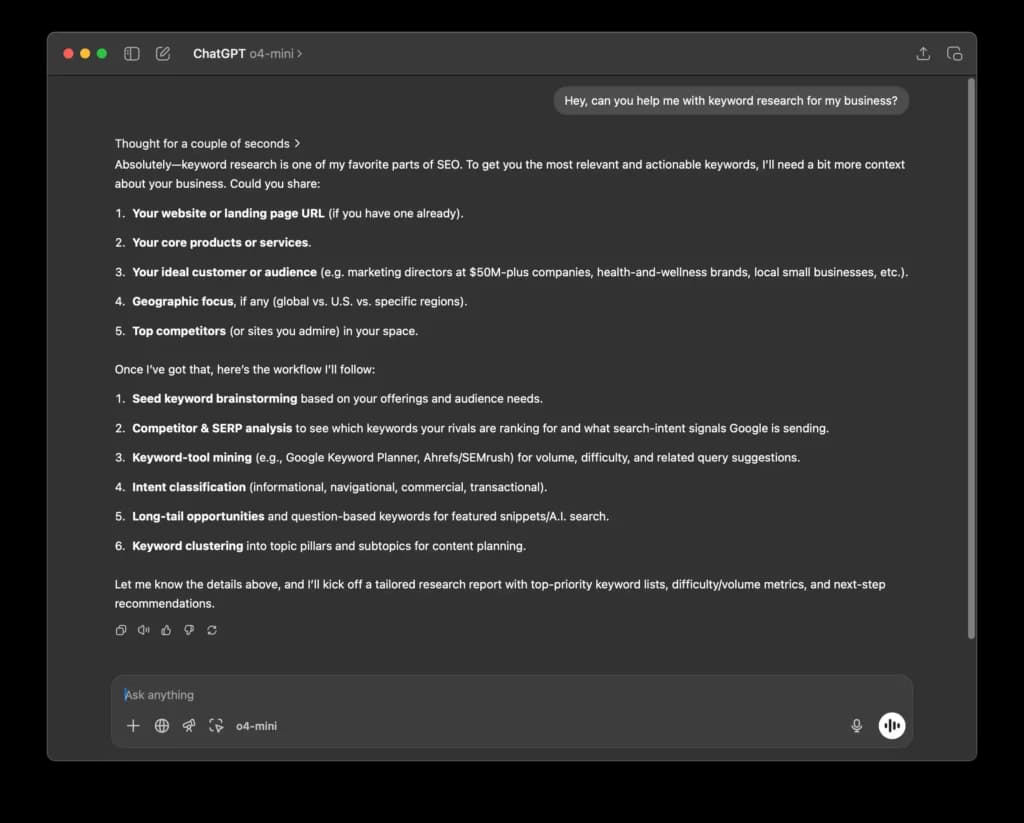
Setting Up ChatGPT for Keyword Research
To get the most out of ChatGPT for keyword research, start with the right setup:
- Choose the right model: GPT-4 or later versions provide the most nuanced understanding of search behavior and SEO concepts.
- Set the context: Begin your session by establishing that you’re using it for keyword research and briefly describe your business or website.
- Provide constraints: Specify your target audience, geographic focus, and any industry-specific parameters.
- Create a system: Use a consistent format for your prompts to make the outputs easier to process and integrate with your other keyword research tools.
Here’s a sample setup prompt:
I'm conducting keyword research for [your business type]. My target audience is [audience description]. I'm focusing on [geographic area] and specifically interested in keywords related to [topic area]. Please help me identify valuable keywords that would drive qualified traffic to my website.Structured Prompts for Keyword Discovery
The quality of ChatGPT’s output depends entirely on the quality of your prompts. Here are proven prompt structures that yield valuable keyword insights:
1. The Persona-Based Prompt
ROLE: Act as a [target customer type] who is looking to [solve problem/achieve goal].
TASK: Generate a list of 15 search queries you might use when researching this topic online.
REQUIREMENTS:
- Include a mix of informational, commercial, and transactional queries
- Vary the query length from short to long-tail
- Include questions and non-question formats
- Note the search intent beside each query
FORMAT: Present as a numbered list with search intent labeledExample:
ROLE: Act as a small business owner who is looking to improve their local SEO.
TASK: Generate a list of 15 search queries you might use when researching this topic online.
REQUIREMENTS:
- Include a mix of informational, commercial, and transactional queries
- Vary the query length from short to long-tail
- Include questions and non-question formats
- Note the search intent beside each query
FORMAT: Present as a numbered list with search intent labeled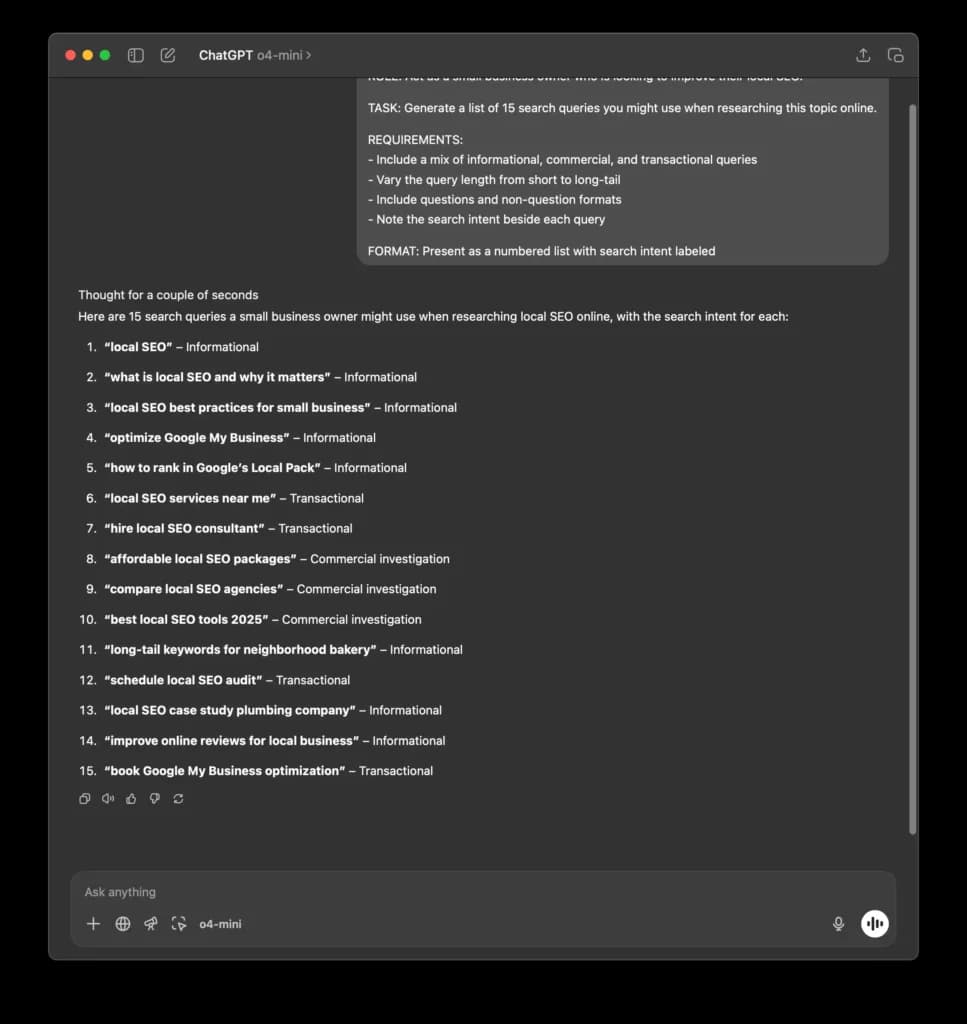
2. The Keyword Expansion Prompt
CONTEXT: I'm targeting the keyword "[seed keyword]" for my content.
TASK: Generate 20 related long-tail keywords that include this term.
REQUIREMENTS:
- Organize keywords by search intent (informational, commercial, transactional)
- For each keyword, provide a brief explanation of why someone might search for it
- Include keywords for different stages of the buyer's journey
- Suggest at least 5 question-based variations
FORMAT: Organize in a table with columns for Keyword, Search Intent, and Search MotivationAnalyzing and Refining ChatGPT Suggestions
ChatGPT generates ideas quickly, but not all suggestions will be winners. Here’s how to refine and prioritize its output:
- Cross-reference with data tools: Take ChatGPT’s suggestions and run them through Ahrefs or The SEO Hustler’s Advanced Keyword Analysis Tool to get volume and difficulty data.
- Look for patterns: Group similar suggestions to identify themes and topic clusters.
- Evaluate search intent alignment: Ensure the suggested keywords match the type of content you plan to create.
- Check for relevance: Some suggestions might be technically related but not relevant to your business offerings.
- Prioritize by business impact: Identify which keywords are most likely to drive qualified traffic that converts.
Free Keyword Research Tools and Techniques
Google Search Console: Mining Your Existing Keywords
Before you go hunting for new keywords, make sure you’re maximizing what’s already working. Google Search Console is a goldmine of keyword data that’s specific to your site—and completely free.
Here’s how to extract actionable keyword insights:
- Log into Google Search Console and select your property
- Navigate to “Performance” in the left sidebar
- Set the date range to the last 3 months for meaningful data
- By default, you’ll see Total Clicks, Impressions, Average CTR, and Average Position
- Click on “Queries” to see the exact keywords driving traffic
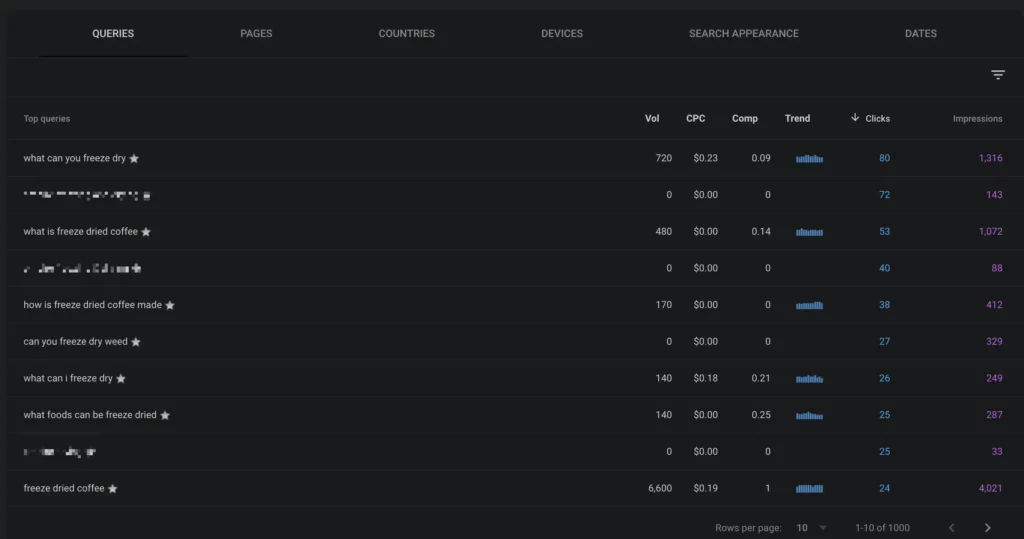
Look for these opportunities:
- Position 8-20 keywords: These are in striking distance of page one. A little optimization could move them up significantly.
- High impression, low click keywords: These show in search but aren’t getting clicked. Improve your title tags and meta descriptions.
- High CTR, low position keywords: People want to click these when they see them. Prioritize improving these rankings.
Google Keyword Planner: The Basics and Limitations
Google Keyword Planner is the OG of keyword research tools. While it’s designed for Google Ads, you can use it for organic keyword research too—with some caveats.
To access it:
- Sign in to a Google Ads account (you don’t need an active campaign)
- Navigate to Tools & Settings > Keyword Planner
- Choose “Discover new keywords” or “Get search volume and forecasts”
The tool provides:
- Monthly search volume ranges (exact numbers require active ad spend)
- Competition level (for ads, not organic)
- Suggested bid amounts
- Related keyword ideas
- Historical metrics and forecasts
Google Trends: Identifying Seasonal and Trending Topics
Google Trends is criminally underused in keyword research. While it doesn’t provide absolute search volumes, it shows relative popularity over time—perfect for:
- Identifying seasonal patterns
- Spotting rising topics before they peak
- Comparing keyword popularity
- Understanding geographic interest
- Finding related topics and queries
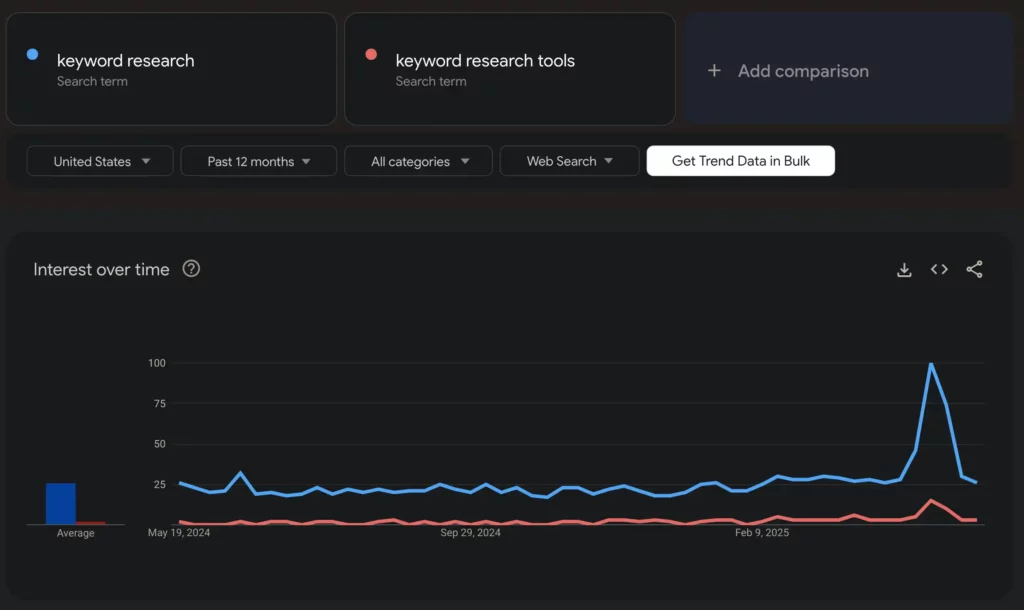
Google Search: Autocomplete, Related Searches, and People Also Ask
The Google search page itself is packed with keyword research features hiding in plain sight:
Autocomplete
Start typing your seed keyword and note the suggestions. These represent common searches and can reveal:
- Questions people ask
- Modifiers they use
- Problems they’re trying to solve

People Also Ask
These expandable questions in search results are keyword gold because they:
- Represent real questions users ask
- Can be targeted with FAQ content
- Often have less competition than main keywords
- Provide insight into the broader topic ecosystem
- Expand with more related questions as you click them
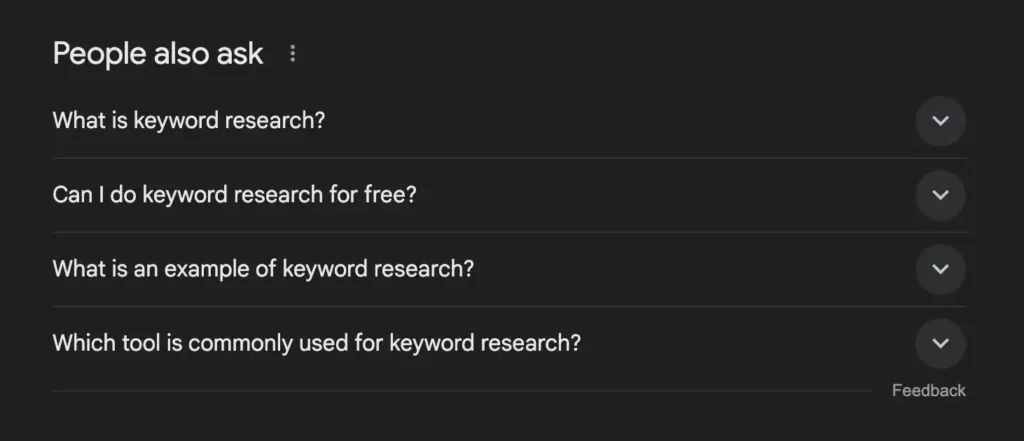
YouTube Keyword Research Techniques
YouTube is the second largest search engine in the world, with its own keyword ecosystem. Even if you don’t create video content, YouTube keyword research can inform your overall strategy.
Here’s how to mine YouTube for keywords:
YouTube Autocomplete
Just like Google, YouTube’s search bar offers autocomplete suggestions that reveal popular searches.
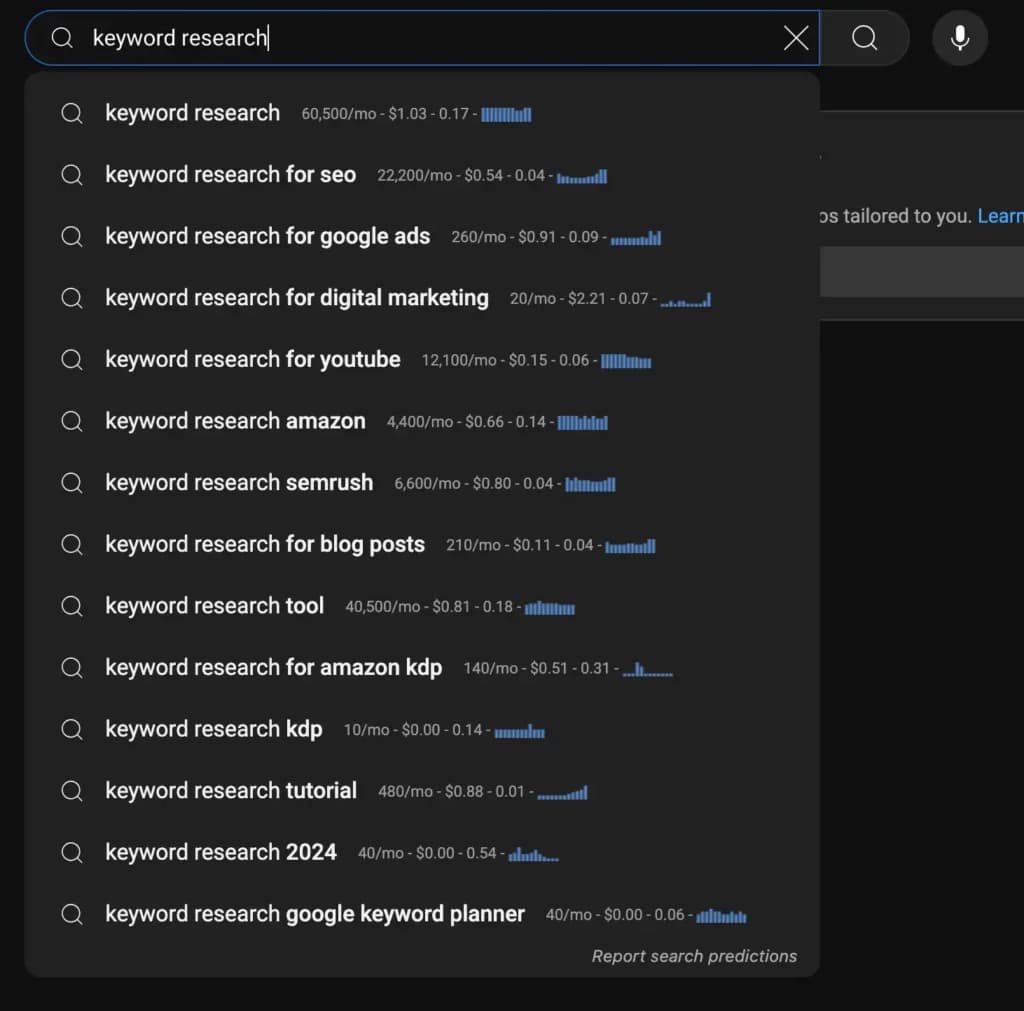
YouTube Search Results
After searching, look at:
- The titles of top-ranking videos
- The descriptions of popular videos
- The tags used (visible with browser extensions like TubeBuddy or vidIQ)
- The chapters/timestamps used in popular videos
- Common themes in thumbnails
Reddit, Quora, and Other Community Platforms for Keyword Ideas
Want to know what real people are asking about your topic? Community platforms are a goldmine of natural language queries and pain points.
Reddit Research
- Find relevant subreddits in your niche
- Sort by “Top” posts from the past year
- Look for patterns in questions and discussions
- Use the search function within relevant subreddits
- Note terminology and phrases unique to your audience

Analyzing Search Intent and Competition
The Four Types of Search Intent (With Examples)
Understanding search intent is crucial for creating content that ranks and converts. Let’s explore each type in detail:
1. Informational Intent
Users want to learn something or answer a question.
- Examples: “how to do keyword research,” “what is SEO”
- Content types: Guides, tutorials, explanatory articles, videos
- Conversion strategy: Email capture, content upgrades, related service offers
2. Navigational Intent
Users want to find a specific website or page.
- Examples: “facebook login,” “ahrefs keyword explorer”
- Content types: Homepage, main service pages, login pages
- Conversion strategy: Clear navigation, featured products/services
3. Commercial Investigation Intent
Users are researching before making a purchase decision.
- Examples: “best keyword research tools,” “ahrefs vs semrush”
- Content types: Comparison pages, reviews, case studies
- Conversion strategy: Free trials, demos, consultations
4. Transactional Intent
Users are ready to make a purchase or complete an action.
- Examples: “buy ahrefs subscription,” “hire SEO consultant”
- Content types: Product pages, service pages, checkout pages
- Conversion strategy: Clear CTAs, streamlined purchase process
The key is matching your content type to the dominant intent. A product page won’t rank for an informational query, no matter how well-optimized it is.
Analyzing SERP Features to Understand Intent
The search results page itself reveals what Google thinks users want:
- Featured Snippets: Indicates informational intent
- People Also Ask: Shows related questions (informational)
- Shopping Results: Signals transactional intent
- Video Carousels: Suggests tutorial or demonstration content works well
- Local Pack: Indicates local service or business intent
- Reviews: Suggests commercial investigation intent
Study these features for your target keywords to understand what content format Google prefers.
Competitive Analysis: Who’s Ranking and Why
Before creating content, analyze the current top-ranking pages:
- Domain Authority: How authoritative are the ranking sites?
- Content Type: Are they guides, listicles, product pages, etc.?
- Content Length: What’s the average word count?
- Content Structure: How are the pages organized?
- Media Usage: What types of images, videos, or tools do they include?
- Freshness: How recently were the pages updated?
- Backlink Profile: How many quality links point to these pages?
- User Experience: How fast, mobile-friendly, and engaging are they?
This analysis reveals the “price of admission” for ranking on page one.
Identifying Content Gaps and Opportunities
The best keyword opportunities often come from identifying gaps in existing content:
- Missing Information: Important subtopics not covered by competitors
- Outdated Content: Old statistics or deprecated methods
- Poor User Experience: Slow, cluttered, or mobile-unfriendly pages
- Weak Media: Text-only content where visuals would help
- Shallow Coverage: Surface-level content that lacks depth
- Missing Formats: No video when users want demonstrations
- Credibility Gaps: Content without expert quotes or citations
Document these gaps to create content that’s genuinely better than what’s currently ranking.
Prioritizing Keywords for Maximum Impact
Creating a Keyword Scoring Framework
Not all keywords are created equal. A scoring framework helps you prioritize objectively:
Business Relevance (1-5)
- 5: Directly related to your core products/services
- 3: Related to adjacent offerings
- 1: Tangentially related to your business
Search Volume (1-5)
- 5: High volume relative to your niche
- 3: Moderate volume
- 1: Low volume
Competition (1-5)
- 5: Low competition, achievable rankings
- 3: Moderate competition
- 1: High competition, difficult to rank
Conversion Potential (1-5)
- 5: High purchase intent
- 3: Moderate intent (information gathering)
- 1: Low intent (casual browsing)
Resource Requirements (1-5)
- 5: Easy to create with existing resources
- 3: Moderate effort required
- 1: Significant investment needed
Add these scores for each keyword (max 25 points). Prioritize keywords with the highest total scores.
Balancing Short-Term and Long-Term Opportunities
A balanced keyword strategy includes:
Short-Term Wins (20% of effort)
- Low-competition, long-tail keywords
- Featured snippet opportunities
- Existing content optimization
- Local or niche-specific terms
Medium-Term Growth (50% of effort)
- Moderately competitive keywords
- Topic clusters around core themes
- Content gaps in your industry
- Trending topics with staying power
Long-Term Authority Building (30% of effort)
- Competitive, high-volume keywords
- Evergreen cornerstone content
- Industry-defining topics
- Brand-building terms
This balanced approach ensures continuous traffic growth while building toward bigger opportunities.
Organizing Keywords into Topic Clusters
Topic clustering improves SEO by establishing topical authority:
- Identify Pillar Topics: Broad subjects central to your business
- Map Cluster Subtopics: Related keywords that connect to the pillar
- Create Hierarchy: Organize from general to specific
- Plan Internal Linking: Connect cluster content to pillar pages
- Assign Content Types: Determine appropriate formats for each cluster
This structure helps search engines understand your site’s expertise areas while providing clear navigation for users.
Aligning Keywords with the Buyer’s Journey
Match keywords to each stage of the customer journey:
Awareness Stage
- Informational keywords
- Problem-focused terms
- “What is,” “how to,” “why” questions
- Industry trends and concepts
Consideration Stage
- Comparison keywords
- Solution-focused terms
- “Best,” “top,” “vs,” “alternatives” modifiers
- Reviews and case studies
Decision Stage
- Transactional keywords
- Brand + product terms
- “Buy,” “price,” “discount,” “near me” modifiers
- Specific product features
This alignment ensures you’re capturing potential customers at every stage of their journey.
Implementing Your Keyword Strategy
On-Page Optimization Best Practices
Once you’ve selected your target keywords, implement them effectively:
Title Tag
- Include your primary keyword near the beginning
- Keep under 60 characters
- Make it compelling and clickable
- Include a benefit or unique angle
Meta Description
- Include your primary keyword naturally
- Keep under 155 characters
- Include a clear call-to-action
- Highlight unique value proposition
URL Structure
- Include your primary keyword
- Keep it short and readable
- Use hyphens to separate words
- Avoid parameters and unnecessary numbers
Heading Structure
- Use H1 for your main title (include primary keyword)
- Use H2s for main sections (include secondary keywords)
- Use H3s for subsections (include tertiary keywords)
- Maintain logical hierarchy
Content Body
- Include your primary keyword in the first 100 words
- Use secondary keywords throughout naturally
- Maintain 1-2% keyword density (not too sparse, not too dense)
- Use variations and synonyms for semantic richness
Images
- Include keywords in image filenames
- Add descriptive alt text with keywords where relevant
- Compress images for speed
- Use descriptive captions where appropriate
Creating Content That Ranks and Converts
Great content satisfies both search engines and users:
- Match Search Intent: Create the content type users expect
- Provide Comprehensive Coverage: Answer all related questions
- Structure for Scannability: Use clear headings, bullets, and short paragraphs
- Include Visual Elements: Add images, videos, or infographics
- Optimize for Featured Snippets: Use clear definitions, steps, and lists
- Add Unique Value: Include original research, expert quotes, or unique angles
- Include Conversion Elements: Add relevant CTAs without being pushy
- Ensure Technical Quality: Make it fast, mobile-friendly, and accessible
Remember: The goal isn’t just ranking—it’s converting that traffic into customers.
Tracking and Measuring Keyword Performance
Set up systems to track your keyword strategy’s effectiveness:
Key Metrics to Monitor
- Rankings for target keywords
- Organic traffic to optimized pages
- Engagement metrics (time on page, bounce rate)
- Conversion rates from organic traffic
- Keyword visibility (percentage of keywords in top positions)
Tracking Tools
- Google Search Console for keyword performance
- Google Analytics for traffic and conversion data
- Rank tracking tools for position monitoring
- Heatmap tools for user engagement analysis
Reporting Cadence
- Weekly: Quick ranking checks for priority keywords
- Monthly: Comprehensive performance review
- Quarterly: Strategic assessment and adjustment
Use this data to refine your strategy, doubling down on what works and pivoting away from what doesn’t.
Updating and Refreshing Content
Keyword rankings aren’t permanent. Maintain your positions by:
- Regular Content Audits: Review all content quarterly
- Freshness Updates: Add new information, statistics, and examples
- Competitive Monitoring: Check if competitors have improved their content
- Consolidation: Merge similar content that might be competing internally
- Format Enhancements: Add new media types or interactive elements
- User Feedback Integration: Address questions from comments or support
Google rewards fresh, updated content that continues to serve user needs.
Advanced Keyword Research Techniques
Finding Low-Competition Keywords with High Traffic Potential
The holy grail of keyword research is finding terms with high traffic potential but low competition. Advanced techniques include:
The Middleman Method
- Find high-volume, high-competition keywords
- Identify sites ranking in positions 5-10
- Use Ahrefs to see what other keywords these “middleman” sites rank for
- Look for keywords where they rank in top positions
- These are likely lower-competition opportunities
The Niche Modifier Technique
- Take a competitive keyword
- Add industry-specific modifiers
- Check competition levels for these longer variations
- Target the ones with meaningful volume but lower competition
The SERP Feature Opportunity
- Identify keywords with SERP features (featured snippets, PAA boxes)
- Analyze the current feature content for weaknesses
- Create better-structured, more comprehensive content specifically designed to win that feature
Keyword Research for International SEO
Expanding globally requires adapting your keyword strategy:
- Don’t Just Translate: Direct translations often miss cultural nuances and local search behavior
- Use Local Keyword Tools: Set your research tools to the target country and language
- Consult Native Speakers: Verify terminology and phrasing with locals
- Analyze Local Competitors: See what keywords they target in each market
- Consider Regional Variations: Even the same language differs between countries (US vs. UK English)
- Check Search Volume by Country: A popular term in one country may be rarely used in another
Voice Search Optimization Strategies
As voice search grows, optimize for these conversational queries:
- Focus on Questions: Voice searches are typically phrased as questions
- Target Conversational Keywords: Use natural language patterns
- Optimize for Local Searches: Many voice searches have local intent
- Create FAQ Content: Directly answer common questions
- Aim for Featured Snippets: Voice assistants often pull from these
- Consider Context: Voice searches often include situational context
Keyword Research for E-commerce
E-commerce sites need specialized keyword approaches:
Product Page Keywords
- Specific product names and models
- Product features and specifications
- Problem-solving terms
- Comparison terms (vs, or, alternative)
Category Page Keywords
- Broader product category terms
- Qualifying adjectives (best, cheap, professional)
- Use case terms (for, with, without)
Seasonal and Trend Optimization
- Identify seasonal patterns in product searches
- Prepare content 2-3 months before peak seasons
- Monitor Google Trends for emerging product interests
- Create “best of [year]” content for annual searchers
Building Your Keyword Research Process
Creating a Repeatable Keyword Research Workflow
The difference between occasional keyword research and sustainable SEO success is having a systematic, repeatable process. Let’s build a workflow you can use again and again.
The 7-Step Keyword Research Framework
- Define Objectives and Scope
- Set clear business goals for the research
- Define target audience segments
- Establish content types to be created
- Set timeline and resource constraints
- Determine success metrics
- Generate Seed Keywords
- Brainstorm initial terms based on business offerings
- Extract terms from customer communications
- Review competitor terminology
- Analyze existing content performance
- Gather team input across departments
- Expand and Discover
- Use tools to find related keywords
- Explore long-tail variations
- Identify questions and problems
- Research trending topics
- Analyze search intent patterns
- Analyze and Filter
- Evaluate search volume and trends
- Assess competition and difficulty
- Confirm search intent alignment
- Check business relevance
- Remove irrelevant or impossible terms
- Prioritize and Organize
- Score keywords using your chosen framework
- Group keywords into topical clusters
- Map keywords to content types
- Align with marketing calendar
- Distribute across short and long-term goals
- Implement and Create
- Develop content briefs
- Optimize existing content
- Create new content
- Update technical SEO elements
- Build internal linking structure
- Measure and Refine
- Track ranking improvements
- Monitor traffic and engagement
- Analyze conversion performance
- Identify underperforming keywords
- Adjust strategy based on results
Document this process as a standard operating procedure (SOP) that your team can follow consistently.
Time-Saving Techniques and Shortcuts
Keyword research can be time-consuming, but these techniques will help you work smarter:
Automation Shortcuts
- Set up Google Sheets templates that pull data from APIs
- Create saved filters in your keyword tools for quick analysis
- Use browser extensions to quickly extract SERP data
- Build custom dashboards for regular keyword monitoring
- Set up alerts for ranking changes on priority keywords
Focus Techniques
- Start with your top 20% of products/services that drive 80% of revenue
- Prioritize keywords with clear commercial intent first
- Focus initial efforts on low-competition, high-relevance terms
- Target keyword clusters rather than individual terms
- Leverage existing content before creating new pages
How Often to Refresh Your Keyword Research
Keyword research isn’t a one-and-done task. Here’s when to revisit and refresh:
Recommended Review Cadence
- Quarterly: Review performance of existing keywords and identify new opportunities
- Bi-annually: Conduct deeper competitive analysis and trend research
- Annually: Perform comprehensive keyword strategy review and alignment with business goals
Trigger-Based Reviews
- Product/Service Changes: When launching new offerings or retiring old ones
- Algorithm Updates: After major search engine algorithm changes
- Competitive Shifts: When competitors make significant strategy changes
- Performance Drops: If rankings or traffic decline unexpectedly
- Seasonal Preparation: 2-3 months before major seasonal periods
Remember: The market, your competitors, and search engines are constantly evolving. Your keyword strategy must evolve too.
Smart Questions You Can Ask About Keyword Research
Conclusion: Taking Action
Your 30-Day Keyword Research Action Plan
Turn this playbook into results with this 30-day plan:
Days 1-3: Foundation
- Define your business goals and target audience
- Set up your keyword research tools
- Create your scoring framework
- Identify 5-10 seed keywords
Days 4-10: Discovery
- Expand your seed keywords using multiple tools
- Analyze competitor keywords
- Mine Google Search Console data
- Explore community platforms for ideas
- Compile a master list of potential keywords
Days 11-17: Analysis
- Analyze search intent for each keyword
- Check competition levels
- Apply your scoring framework
- Organize keywords into topic clusters
- Prioritize your opportunities
Days 18-24: Implementation
- Create content briefs for top priorities
- Optimize existing content for quick wins
- Develop new content for gap opportunities
- Update technical SEO elements
- Implement proper internal linking
Days 25-30: Measurement & Refinement
- Set up rank tracking
- Establish performance baselines
- Create a content calendar for ongoing work
- Document your process for repeatability
- Plan your next 30-day cycle
Common Pitfalls to Avoid
Even experienced SEOs make these keyword research mistakes:
- Chasing Volume Over Intent: High volume means nothing if the traffic doesn’t convert
- Ignoring Competitive Reality: Be realistic about what keywords you can rank for now
- Keyword Stuffing: Focus on creating valuable content, not cramming in keywords
- Neglecting Long-Tail Opportunities: These often offer the best ROI
- Static Research: Keyword landscapes change; regularly refresh your research
- Siloed Thinking: Share keyword insights across marketing, product, and sales teams
- Impatience: SEO takes time; don’t abandon keywords before they’ve had a chance to rank
Final Thoughts: The Ongoing Keyword Journey
Keyword research isn’t a one-time project—it’s an ongoing process of discovery, analysis, implementation, and refinement. The digital landscape constantly evolves, with new search behaviors emerging and competition shifting.
The most successful SEO professionals and businesses make keyword research a habit, not a task. They stay curious about how their audience searches, remain alert to new opportunities, and continuously optimize based on performance data.
Remember: Every successful SEO strategy begins with understanding what your audience is searching for and why. Master keyword research, and you master the foundation of digital marketing success.
Now it’s your turn. Take what you’ve learned, apply it to your unique situation, and start connecting with the people who are already looking for what you offer. They’re searching right now—make sure they find you.